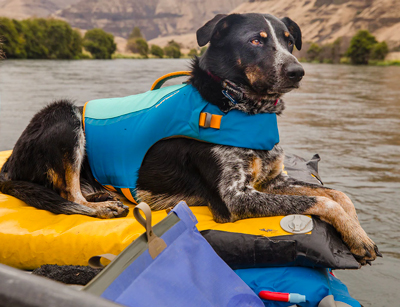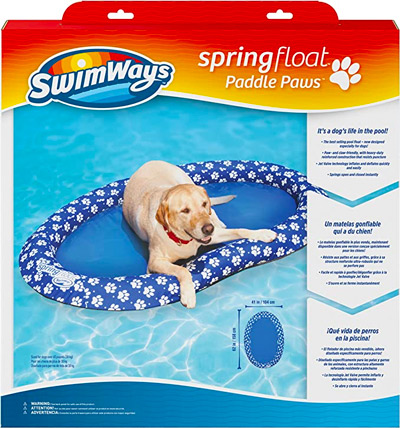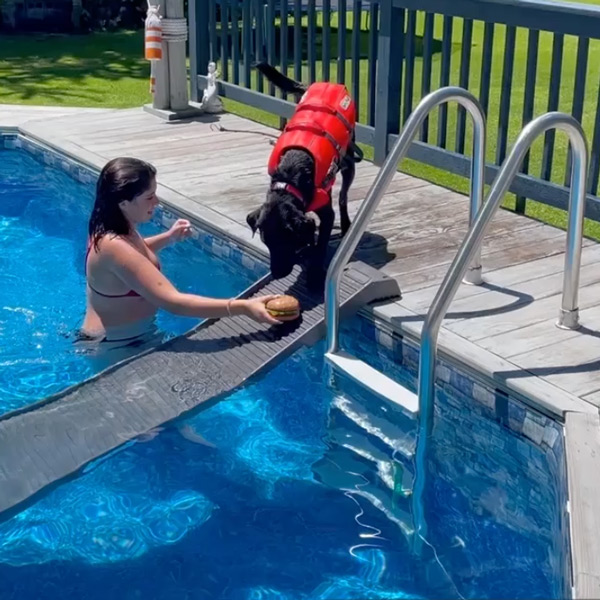-
- SHOP
- Pool Ramp for Dogs
- For People
- For Pets
- Gallery
- Blog
- Our Company
- Cart
- Login
- Newsletter
- Free US Shipping on orders over $79!
While some dogs may gallop towards crashing waves, eager to swim, others may be wary to even dip the tips of their paws into a puddle. My dog, for one, loves to wade into any water he can find but avoids actually swimming. I think he’d enjoy it if he tried, but there’s definitely a bit of hesitation there. If your dog isn’t the strongest swimmer or if you want to help them feel more confident in the water, it can be a good idea to teach them to swim for both their own safety and enjoyment.
Dogs instinctively know to start paddling if they find themselves in deeper water. However, this doesn’t mean that they know how to successfully swim. That’s why in many cases it’s better to facilitate swimming lessons with your dog instead of waiting to see if they’ll sink or swim on family lake day.
If you’ve ever watched dogs playing at the beach, you’ve probably noticed how each dog enjoys the water to a different degree. Besides just good old-fashioned practice, some dogs are simply better at swimming than others because of their breeding. When breeding water-loving dogs, breeders selected dogs that had a natural inclination to water and that enjoyed swimming. Certain dog breeds were bred to enjoy the water for specific reasons like being able to assist in water rescues or to retrieve waterfowl when hunting. Because of that, dog breeds like retrievers, poodles, Newfoundlands, or Portuguese water dogs will most often gravitate towards the water and will be skilled swimmers.

However, water-loving dogs are not always exclusive to just those breeds. You may have a golden retriever that hates getting wet or a Yorkie that loves to swim! As a general rule of thumb, you should observe how your dog naturally interacts with water before trying to get them to swim in your pool. It is also important to understand the ins and outs of the water your dog will be swimming in before they take the plunge.
As you probably know from your own experience, swimming in open water like oceans, lakes, rivers, or ponds can be very different from swimming in a pool. This is especially true for dogs. If your family is going to be spending a lot of time on the lake or other bodies of water this summer, it’s important to take into consideration how open water can have its own swimming risks for your dog.
While the water in your pool is usually calm, open water can be unpredictable. If swimming in an ocean or lake, there can be powerful waves as well as rip currents or undertows. In rivers or streams, the current can vary from a gentle rumble to a roaring force to be reckoned with. Depending on your dog’s size, skill level, and experience, a large wave or strong current can become a dangerous situation.
In either case, it’s important to take into account these safety measures before your dog even starts swimming.
Before your dog starts swimming anywhere, it’s vital to be aware of the potential dangers present in the water. Because open water is much less predictable, there will usually be more risk factors present. As discussed above, open water can have unpredictable movements like waves, rapids, undertows, and riptides. Before entering, observe the water for any dangerous currents. Since undertows are usually invisible to the naked eye, be sure to stay up to date on any swimming condition updates from your local authorities or lifeguards. Whenever your dog is in the water, be sure to keep a watchful eye on them and take them out of the water if they seem to be struggling to swim.
Secondly, you should always be aware of the other critters your dog will be sharing the water with. While some may be harmless like small fish and waterfowl, open water, especially in southern states, may contain larger predators like alligators. Bodies of water will also attract non-aquatic animals who will visit to drink or hunt. Depending upon where you live, land predators like bears, coyotes, or foxes may make a surprise visit. The best course of action is to keep an eye out for any wild visitors and leave the area if you see one.
Lastly, natural bodies of water can sometimes be contaminated by certain bacteria or algae that can make you and your dog sick. Before swimming, it is always best to read any signs placed around the water to make sure it is safe for swimming. Local authorities will also usually make press releases to the local paper if a popular swimming spot is not currently safe. If you notice that your dog is acting ill after swimming or drinking from a natural body of water, be sure to take them to the vet.

Just as we humans wear life jackets on the water, flotation devices are available to our dogs. There is a collection of canine life jackets available on the market today like this one created by RuffWear. The foam panels in the life vest create buoyancy to help your pup swim and float in the water. If your dog is still learning to swim and become comfortable in the water, a life jacket may be a worthwhile investment. The life jackets may also be especially useful if your dog is swimming in open water as they can help your pup paddle in any unexpected swimming conditions like a large wave or a rip current.
A very inexpensive and readily available water accessory, pool floats can be found at a plethora of online and retail stores. While they will not provide the continuous safety of a life jacket, pool floats can act as a place for your dog to rest while swimming. We recommend only using them in the pool and not on open water where the current can be unpredictable. With a little boost, your dog can also enjoy the water simply by floating around the pool while the rest of your family swims. This pool float was specifically designed for canine use, but pool floats made for humans can also do the trick in most cases.

Like any water activity, your dog should be supervised while on the pool float. Even though the purpose of these floats is to allow your dog to take a rest from swimming and relax, they can also interfere with your dog’s swimming abilities as they drift around the pool.
There are also a few swimming risks to look out for when your dog is in the water. We’ve all felt the fatigue that comes after a long day of fun on the water. Your dog experiences the same thing. It is important to supervise your dog while swimming to ensure that they do not become too fatigued and are able to comfortably keep their heads above the water. Factors such as excessive heat and rough water conditions like strong currents can increase the risk of fatigue, and therefore drowning. To prevent fatigue and drowning, your dog should always have a clear path out of the water, and shouldn’t swim in deep water if not a strong swimmer. Wearing a canine flotation device can also help.
Although not as common, water intoxication can also be a swimming risk for dogs. Water intoxication happens when dogs swallow too much water while swimming, therefore causing dangerously low levels of sodium in the blood. Symptoms of water intoxication include vomiting, fatigue, incoordination, and pale gums. To prevent water intoxication, remain vigilant to make sure your dog can always keep their head above water when swimming, or direct your dog to exit the water if you find them swallowing large amounts even in shallow areas. If your dog presents any of the symptoms listed above, take them to the vet.
Now that we are aware of safety measures that should be taken into account while your dog is swimming, we can focus on some tips to help your dog learn to swim. Since open water can be unpredictable, we’d recommend teaching your dog to swim in a pool if possible. Plus, it’ll be a lot more fun to have your dog swimming with the family during summer pool parties.
If your dog is just beginning to learn how to swim or is a bit wary around water, they will not want to jump head or paw-first into the water. This leaves entry possibilities quite limited if your dog is learning how to swim in your pool. Pool ladders are not made for paws, and pool steps can even be too steep for your dog to comfortably use. The best pool entry option for dogs is a dog ramp. With the pool leg accessory kit, the PetStep ramp transforms into a pool ramp for dogs. That way, your pup can enter the water at their own pace on the gradual slope. If your dog is especially hesitant, it is a good idea for you to enter the water first and lead them down the ramp. Once your dog reaches the end of the ramp, you can gently guide them with your hands to help transition them from standing on the ramp to paddling in the water.
Once your dog has left the ramp, they will instinctively start to paddle. Some dogs will initially resist swimming if possible, and either turn around towards the ramp or cling on to you. Let them go at their own pace, but encourage them to come back into the water. You can walk beside them as they paddle, holding on to them if needed. Just being next to them in the water will help your dog feel more safe and confident while swimming.
As your dog becomes more content in the water, you can try calling them to swim to you at opposite ends of the pool. This will allow your dog to practice their skills while still feeling safe in your presence. In some cases, like if your dog is very hesitant to enter the water, you can use a doggy life vest to help your dog feel more comfortable as they begin swimming. Once they get more used to the water, you can take the life vest off so your dog can start learning to swim on their own.
Like a safe and comfortable entry, it is also important for your dog to always have a reliable exit from the pool. The PetStep pool ramp works the same for an exit as it does for entry, allowing your dog to safely walk out of the pool on their own. When your dog first starts learning to swim, show them how to exit the pool by guiding them up the ramp just as you guided them into the pool. Your dog will be more open to learning when they know that they are not trapped in the water and will always have an easy way out.

As the famous saying goes, practice makes perfect. The same is true for your dog learning to swim. The more your dog swims, the better they will get at it. While you may start by guiding your dog around the pool with your hands, you’ll progress to simply being present in the water while your dog swims on their own.
If your family is going to be out at the pool or on the water this summer, it’s important that your dog also stays safe. Teaching your dog to swim before setting out onto the lake or jumping in the pool can prevent dangerous situations and also helps your dog become part of the fun. Still, no matter your dog’s skill level, it is essential to supervise your dog while swimming. Here’s to a great summer on the water that will create lifelong memories!